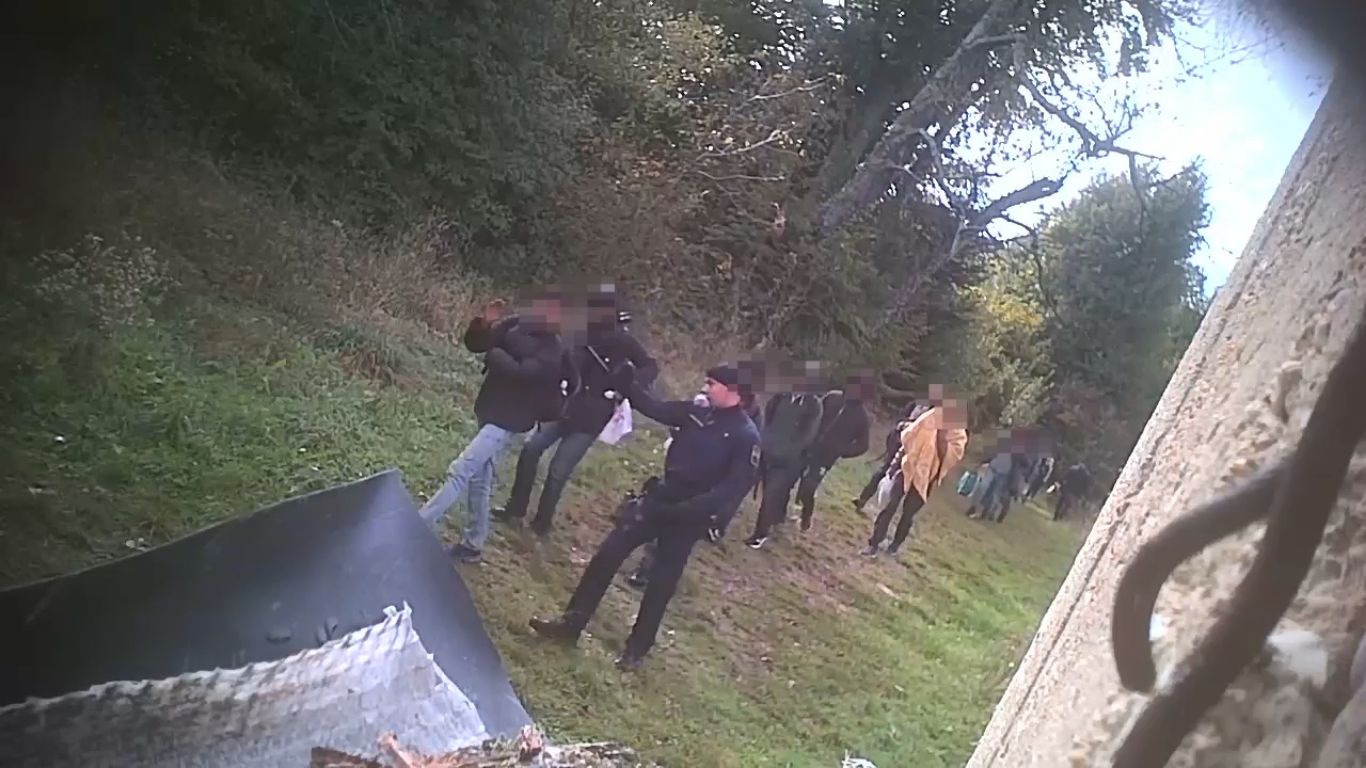After the publication of video footage by Border Violence Monitoring2 on 16th December 2018 showing illegal collective expulsions of people on the move at the EU external border with Bosnia and Herzegovina, more serious allegations were raised against Croatian police officers from several sides.
Save the Children published a report that gathered testimonies of more than 1,350 cases of children being pushed back across European Union borders between January and November 2018. Almost one third of these cases reportedly involved violence inflicted by police or guards at borders. Most of the cases occurred at the Croatian border to Serbia, but they also mention violent practices at the Croatian-Bosnian border.3 No Name Kitchen Kladusa, in cooperation with Balkan Info Van, states in their recently published overview report on border violence to have observed “an increase in the deployment of police forces and violent practices, making legal and safe transit to Europe impossible”, to have “received consistent reports from men, women and children, of abuses that remain either uncovered or denied, leading to no prosecution of the perpetrators and continued border violence.”4 Following these further allegations which are still being denied by the Croatian Ministry of the Interior (MOI) in a statement published after the publication of the video footage, Border Violence Monitoring wants to take a position reacting on some of their points. A well-grounded counteropinion should be voiced through a collection of views expressed by a number of actors who deal on a daily basis with the illegal practices at the Bosnian-Croatian border.
LEGAL FRAMEWORK
The MOI has mainly attempted to justify itself by claiming that the videos do not show expulsions but rather refusals of entry, which are legal in accordance with Article 13 of the Schengen Borders Code.5 However, since Croatia is neither a member state of the Schengen area, nor can the Schengen Borders Code stand above human rights, as stipulated for example in the European Convention on Human Rights, the MOI’s legal interpretation is more than contestable. According to Adel-Naim Reyhani, legal expert at the Ludwig Boltzmann Institute for Human Rights in Vienna, “those who want to claim asylum or international protection should not be refused entry according to the Schengen Borders Code”.6 András Léderer, information and advocacy officer for the human rights group Hungarian Helsinki Committee, points in a similar direction as Reyhani, saying that returning people via the green border without due procedure is even “definitely not in accordance with the Schengen acquis.” Further “these practices breach the prohibition of collective expulsion, enshrined in Article 4 of Protocol 4 of the European Convention on Human Rights, and might even pose security risks to the EU,” Léderer said. “If the migrants entered Croatia before the videos were taken, then in the case of each migrant an individual decision should have been made by the Croatian authorities against which an effective remedy must have been available to the migrant.”7 In addition, the affiliated organisation the Helsinki Committee for Human Rights in Zagreb, also evaluates the video footage as “absolutely credible” and coinciding with their research.8
Several sources prove that a large number of refugees among expelled persons would like to express their intent for seeking international protection in the Republic of Croatia. Center for Peace Studies in Zagreb explains that: “These persons have legal basis for submitting a request in accordance with Article 33 of the International and Temporary Protection Act. In this way, they could regulate their stay, but the entire practice of the Ministry, as well as the conduct of specific police officers, is done precisely to prevent them from doing so. The Directive is clear here (Directive (2008/115/EC)), it clearly states and prescribes that the return measures do not apply to persons whose international protection request has not yet been resolved. The fact of police departure outside of the territory of the Republic of Croatia in the cases of expulsion only serves to prove that it conducted in such a way precisely for the purpose of conducting collective expulsion and in order to prevent access to the system of international protection, in the same way as it was established in the famous case of Hirsi Jamaa and others v. Italy.“ Welcome! Initiative emphasizes that the practices that can be seen in the videos “are not isolated and sporadic cases of illegal push-backs nor benign discouragement, but planned and systematic measures done without any legal basis which include denial of access to the international protection and violation of non-refoulement principles.” Welcome! Initiative published several reports on the serious state of affairs in cooperation with the NGOs Are You Syrious, No Name Kitchen and Center for Peace Studies Zagreb,9 denouncing “that the Republic of Croatia denies access to legal rights to the individuals and groups who approach or enter the country without legal documents in contrast to the national and international legal regulations.” What is unacceptable to them is the fact that “the Croatian Ministry of Interior keeps denying that these illegal practices are happening and at the same time shows no evidence that such actions had not occurred” while trying “to shift responsibility to the refugees, but also to organizations and institutions that have pointed out the violence and illegal practices.”
EXTENSIVE EVIDENCE
There are several actors monitoring the borders in Eastern Europe for quite a while, drawing parallels between the Bosnian-Croatian border and others. Diego Saccora, spokesperson of the Italian NGO “Lungo la rotta balcanica – Along the Balkan Route” which is following the development of the Balkan route(s) since 2015, emphasizes the fact that the practices they are witnessing on the Croatian borders are similar to those witnessed at the Greek, Italian and other borders. “When you live for a period near the border it is impossible not to see how much push-backs are a reality. There are articles, reports, books and documentaries of all kinds to prove this systematic practice. We believe that there is no real need for further evidence.” Dan Song, staff member of the NGO “Fresh Response” which was based in Subotica near the Serbian-Hungarian border points out that “the general practices corroborated by hundreds of pages of testimonials, photos, and medical reports share strong similarities to what we’ve observed and documented at the Hungarian-Serbian border in 2016-17, from patterns of beating implying systemization of violence, humiliating and degrading treatment, and destruction of personal property.” The main difference, according to Song, is “while the Croatian MOI attempts to justify these blatantly illegal practices as legitimate, the Hungarian authorities passed legislation (in contravention of EU and international law) to legitimize such pushbacks from within their territory.”
Many renowned organizations underline that the published videos achieve reversal of the burden of proof and show that they are not just isolated incidents but rather part of a general deterrence strategy and systematic human rights violations: Médecins Sans Frontières‘ medical team treated several people for various injuries and referred some people for x-rays and further investigations in the local hospitals in Bosnia and Herzegovina. Wounds that are seen in their mobile clinic vary from soft tissue injuries to fractures that are consistent with exposure to physical force on the specific body parts.10 Julian Koeberer, Humanitarian Affairs officer in the northern Balkans states on their mission: “Our medical team in Bosnia regularly receives patients who come to the clinic with wounds allegedly inflicted by Croatian Border Forces. Any form of violence used as deterrence, whether physical or psychological ill-treatment is absolutely unacceptable. The amount of allegations is overwhelming, have to be taken seriously and therefore they need to be urgently investigated transparent and thoroughly.” Human Rights Watch mentions the same assessment in their December report: none of the people they interviewed underwent any formal return procedure before being forced back over the border. “Croatia has an obligation to protect asylum seekers and migrants,” said Lydia Gall, Balkans and Eastern EU researcher at Human Rights Watch. “Instead, the Croatian police viciously beats asylum seekers and pushed them back over the border.”11
CALL FOR INVESTIGATIONS
The NGOs’ accusations are not new, neither is the demand for a serious investigation by other political actors: Dunja Mijatović, Human Rights Commissioner of the Council of Europe had already urged the Croatian authorities in September to investigate “the alleged collective expulsions from Croatia to Serbia and Bosnia and Herzegovina and police violence against migrants”. She is concerned that Croatia did not allow the national ombudswoman access to police files in order to carry out investigations.12: The Croatian Ombudswoman already issued a report to the State Attorney of the Republic of Croatia stating that Ministry of Internal Affairs systematically works on covering up their mistreatment of refugees. Mijatović is not the only one demanding for investigations: In September 2018, 22 MEPs request a parliamentary interrogation on the living conditions of migrants in BiH. ”The situation is serious,” Italian MEP Elly Schlein said, “we are asking the European Commission what initiatives it plans to take to monitor the dramatic conditions of migrants on the border between Croatia and Bosnia-Herzegovina and to ensure that their fundamental rights are respected.”13 A broader cooperation with Bosnian authorities seems appropriate for investigations as, reacting to the publication of the video footage by BVM, Minister of Security of Bosnia and Herzegovina Dragan Mektić confirmed that BiH has evidence that “refugees are even physically abused”.14
Dimitris Avramopoulos answered on behalf of the European Commission that they are aware of the allegations of mistreatment of third-country nationals and the lack of possibility to apply for asylum “The Commission expects Croatia to follow up on this issue. The Commission will continue to closely monitor the situation, including being in contact with the authorities”, especially “concerning the implementation of the Common European Asylum System”15
We call on the European Commission to follow through with this concern and treat it as a matter of high priority. We further demand a call by the European Commission on Croatia to halt and transparently investigate the collective expulsions (so called push-backs) of asylum seekers to Bosnia and Herzegovina, allegations of violence against asylum seekers and chain-push-backs from Slovenia to Croatia and then to Bosnia and Herzegovina. The number and weight of the dissenting votes listed in this statement speak for itself and should be absolutely sufficient as a well-founded suspicion to be investigated by the responsible authorities. The European Commission should also monitor the cross-border denial of asylum and push-backs of migrants and asylum seekers by European Union Border Officials, including to hold the responsible implicated officials to account. Full cooperation with the Ombudswoman’s should be guaranteed, as required by national law. Money allocated by the EU for the purpose of border security should be extensively examined of its usage.
_______________________________________________________________________________________
1 In reference to an assertion by the MOI of Croatia: Dnevnik.hr (16.12.2018): MUP o snimkama: “Ne radi se o protjerivanju, već o zakonitom odvraćanju migranata s državne granice”; https://dnevnik.hr/vijesti/hrvatska/mup-reagirao-na-snimke-border-violence-monitoringa—542504.html
2 https://www.borderviolence.eu/proof-of-push-backs/
3 Save the Children (24.12.2018): Hundreds of children report police violence at EU borders; https://www.savethechildren.net/article/hundreds-children-report-police-violence-eu-borders
5 Dnevnik.hr (16.12.2018): MUP o snimkama: “Ne radi se o protjerivanju, već o zakonitom odvraćanju migranata s državne granice”; https://dnevnik.hr/vijesti/hrvatska/mup-reagirao-na-snimke-border-violence-monitoringa—542504.html
6 Deutsche Welle (17.12.2018): Schiebt Kroatien Migranten illegal ab; https://www.dw.com/de/schiebt-kroatien-migranten-illegal-ab/a-46765957
7 The Guardian (17.12.2018): Croatia violating EU law by sending asylum seekers back to Bosnia; https://www.theguardian.com/world/2018/dec/17/croatia-violating-eu-law-by-sending-back-asylum-seekers-to-bosnia
8 taz (17.12.2018): Im Wald außer Landes geschafft; https://www.taz.de/Gewalt-gegen-Fluechtlinge-in-Kroatien/!5556715/
9 http://welcome.cms.hr/wp-content/uploads/2017/01/REPORT-ON-ILLEGAL-AND-FORCED-PUSH-BACKS-OF-REFUGEES-FROM-THE-REPUBLIC-OF-CROATIA.pdf
http://welcome.cms.hr/wp-content/uploads/2017/08/THE-SECOND-REPORT-ON-UNLAWFUL-AND-FORCED-PUSH-BACKS-OF-REFUGEES-FROM-THE-REPUBLIC-OF-CROATIA-.pdf
https://www.cms.hr/system/article_document/doc/504/Fourth_Report_on_Illegal_Pushbacks.pdf
10 AlJazeera (28.11.2018): As snow falls in Bosnia, cold adds to ‘assaulted’ refugees’ woes; https://www.aljazeera.com/indepth/features/snow-falls-bosnia-cold-adds-assaulted-refugees-woes-181122222505108.html
11 Human Rights Watch (11.12.2018): Croatia: Migrants Pushed Back to Bosnia and Herzegovina; https://www.hrw.org/news/2018/12/11/croatia-migrants-pushed-back-bosnia-and-herzegovina
12 taz (17.12.2018): Im Wald außer Landes geschafft; https://www.taz.de/Gewalt-gegen-Fluechtlinge-in-Kroatien/!5556715/
13 Info Migrants (09.11.2018): EU Parliament members demand interrogation of Croatia’s treatment of migrants; http://www.infomigrants.net/en/post/11895/eu-parliament-members-demand-interrogation-of-croatia-s-treatment-of-migrants
15 http://www.europarl.europa.eu/doceo/document/E-8-2018-004570-ASW_EN.html

